Tonight, after several nights of battling my larval rack, I finally pulled of the split of Spawn #20 into two separate groups. Long story short, I had taken off two BRTs off a shelf that had somehow “Dropped” on the one side. Both BRTs got a full scrubbing followed by a wipedown with hydrogen peroxide. Meanwhile, I spent 2 nights and 3 days banging on the shelf with a rubber mallet until I finally freed up the shelf from the plastic locking mechanisms. Thankfully I saved some of the extra plastic parts that came with the epoxy-coated wire shelves, and was able to reset the shelf height and set the BRTs back up.
Once the larviculture tanks were set back up, it was easy to simply scoop out half of the water and larvae from the 10 gallon tank. I took a photo of the larvae in the bucket so I can count how many I moved into the BRT. Just as I scooped the babies from the 10 gallon into a 5 gallon bucket, I in turn did the same thing to introduce them to an empty, sanatized BRT.
I’ve continued with doing daily water changes on the larvae and have, at this point, dropped the specific gravity from 1.025 down to 1.018. I’m also doing nightly infusions of rotifers that have been enriched for an hour or two with Super Selcon.
In other news, Spawn #21 was put down this evening (1-9-2014) by the Lighting Maroon pair.
- About The Lightning Project
- Inventory of F1 PNG Lightning and White Stripe Maroon Clownfish
- F1 PNG Lightning Maroon Clownfish, BZLM1
- F1 PNG Lightning Maroon Clownfish, BZLM2
- F1 PNG Lightning Maroon Clownfish, FW1
- F1 PNG Lightning Maroon Clownfish, LM10
- F1 PNG Lightning Maroon Clownfish, LM11
- F1 PNG Lightning Maroon Clownfish, LM12
- F1 PNG Lightning Maroon Clownfish, LM13
- F1 PNG Lightning Maroon Clownfish, LM14
- F1 PNG Lightning Maroon Clownfish, LM15
- F1 PNG Lightning Maroon Clownfish, LM16
- F1 PNG Lightning Maroon Clownfish, LM17
- F1 PNG Lightning Maroon Clownfish, LM18
- F1 PNG Lightning Maroon Clownfish, LM19
- F1 PNG Lightning Maroon Clownfish, LM20
- F1 PNG Lightning Maroon Clownfish, LM3
- F1 PNG Lightning Maroon Clownfish, LM4
- F1 PNG Lightning Maroon Clownfish, LM5
- F1 PNG Lightning Maroon Clownfish, LM6
- F1 PNG Lightning Maroon Clownfish, LM7
- F1 PNG Lightning Maroon Clownfish, LM8
- F1 PNG Lightning Maroon Clownfish, LM9
- F1 PNG Lightning Maroon Clownfish, MD1
- F1 PNG Lightning Maroon Clownfish, MWP3
- F1 PNG Lightning Maroon Clownfish, WS17
- F1 PNG Lightning Maroon, EC1
- F1 PNG Lightning Maroon, GL1
- F1 PNG White Stripe Maroon Clownfish, BZWS1
- F1 PNG White Stripe Maroon Clownfish, BZWS2
- F1 PNG White Stripe Maroon Clownfish, BZWS3
- F1 PNG White Stripe Maroon Clownfish, WS10
- F1 PNG White Stripe Maroon Clownfish, WS11
- F1 PNG White Stripe Maroon Clownfish, WS12
- F1 PNG White Stripe Maroon Clownfish, WS13
- F1 PNG White Stripe Maroon Clownfish, WS14
- F1 PNG White Stripe Maroon Clownfish, WS15
- F1 PNG White Stripe Maroon Clownfish, WS16
- F1 PNG White Stripe Maroon Clownfish, WS4
- F1 PNG White Stripe Maroon Clownfish, WS5
- F1 PNG White Stripe Maroon Clownfish, WS6
- F1 PNG White Stripe Maroon Clownfish, WS7
- F1 PNG White Stripe Maroon Clownfish, WS8
- F1 PNG White Stripe Maroon Clownfish, WS9
- F1 PNG White Stripe Maroon, EC2
- F1 PNG White Stripe Maroon, FW2
- F1 PNG White Stripe Maroon, GL2
- F1 PNG White Stripe Maroon, MD2
- Lightning Breeding Directive
- Lightning Maroon Clownfish Links
- Home
- About The Lightning Project
- Inventory of F1 PNG Lightning and White Stripe Maroon Clownfish
- F1 PNG Lightning Maroon Clownfish, BZLM1
- F1 PNG Lightning Maroon Clownfish, BZLM2
- F1 PNG Lightning Maroon Clownfish, FW1
- F1 PNG Lightning Maroon Clownfish, LM10
- F1 PNG Lightning Maroon Clownfish, LM11
- F1 PNG Lightning Maroon Clownfish, LM12
- F1 PNG Lightning Maroon Clownfish, LM13
- F1 PNG Lightning Maroon Clownfish, LM14
- F1 PNG Lightning Maroon Clownfish, LM15
- F1 PNG Lightning Maroon Clownfish, LM16
- F1 PNG Lightning Maroon Clownfish, LM17
- F1 PNG Lightning Maroon Clownfish, LM18
- F1 PNG Lightning Maroon Clownfish, LM19
- F1 PNG Lightning Maroon Clownfish, LM20
- F1 PNG Lightning Maroon Clownfish, LM3
- F1 PNG Lightning Maroon Clownfish, LM4
- F1 PNG Lightning Maroon Clownfish, LM5
- F1 PNG Lightning Maroon Clownfish, LM6
- F1 PNG Lightning Maroon Clownfish, LM7
- F1 PNG Lightning Maroon Clownfish, LM8
- F1 PNG Lightning Maroon Clownfish, LM9
- F1 PNG Lightning Maroon Clownfish, MD1
- F1 PNG Lightning Maroon Clownfish, MWP3
- F1 PNG Lightning Maroon Clownfish, WS17
- F1 PNG Lightning Maroon, EC1
- F1 PNG Lightning Maroon, GL1
- F1 PNG White Stripe Maroon Clownfish, BZWS1
- F1 PNG White Stripe Maroon Clownfish, BZWS2
- F1 PNG White Stripe Maroon Clownfish, BZWS3
- F1 PNG White Stripe Maroon Clownfish, WS10
- F1 PNG White Stripe Maroon Clownfish, WS11
- F1 PNG White Stripe Maroon Clownfish, WS12
- F1 PNG White Stripe Maroon Clownfish, WS13
- F1 PNG White Stripe Maroon Clownfish, WS14
- F1 PNG White Stripe Maroon Clownfish, WS15
- F1 PNG White Stripe Maroon Clownfish, WS16
- F1 PNG White Stripe Maroon Clownfish, WS4
- F1 PNG White Stripe Maroon Clownfish, WS5
- F1 PNG White Stripe Maroon Clownfish, WS6
- F1 PNG White Stripe Maroon Clownfish, WS7
- F1 PNG White Stripe Maroon Clownfish, WS8
- F1 PNG White Stripe Maroon Clownfish, WS9
- F1 PNG White Stripe Maroon, EC2
- F1 PNG White Stripe Maroon, FW2
- F1 PNG White Stripe Maroon, GL2
- F1 PNG White Stripe Maroon, MD2
- Lightning Breeding Directive
- Lightning Maroon Clownfish Links
Well honestly, I just don’t know what I did that caused this one to be so much better than any prior to date, but somehow the stars aligned and I wound up with something like 1000 baby Lightning Maroons. And the best part is that I am HERE and able to care for the fish well through metamorphosis. God help me if I screw this one up (which is a real possibility given so many babies in a 10 gallon tank…I *may* wind up splitting the batch).
As you may recall, I pulled the next on the night of 1/1/2014 going into 1/2/2014. I re-read all of Wilkerson’s text just to see if I had missed ANYTHING that could be helpful, and one line may have been the difference.
“If in doubt, err on the side of too much aeration” – Joyce Wilkerson, Page 190, Clownfishes, third printing (2003)
Well, I took that to heart and didn’t dial back my slintered glass airstone…I just let the thing rip faster than I felt comfortable. And that might have been the ticket…it “feels” like that’s the only variable I really changed. That said, I didn’t sanitize the eggs this time, and I started the tank with a mixture of new water and broodstock water vs. all straight one or the other.
In any case, I got the kind of hatch I get most every time with other clownfish species, so maybe I really just need to be more aggressive with my aeration? I’ll obviously follow the same pattern on the next batch and see if it repeats. A whole 2 years almost to dial in on the best hatching protocol…damn…you’d think I was a newb at this. Who knows…
I have photos of this spawn stashed away in the camera, but I figured I better get this on the books before I completely forget. Spawn #19 was put down on 12-14. With tons of stuff going on with the holidays, I did a boneheaded thing and pulled the nest on the night of the 19th going into the 20th (because I looked at my phone after Midnight, didn’t realize it was that late, saw the 20th, and said “shoot I gotta pull this tonight!”).
So the eggs went into a clean tank with all new water after a 15 minute bath on hydrogen peroxide. It was at least 24 hours early, and yet despite that, I had a handful of offspring the next morning…that’s technically 5 days after spawning! A few more offspring hatched out the subsequent night (which would have been 6 days later), and yet after that, the nest died. There has been plenty of RotiGreen Omega and rotifers in the 10 gallon blacked out tank, but by the time I departed for our holidays away, there were maybe only 3 babies I could see alive. Upon returning the day after Xmas (12-26), I could find only one baby in the tank, and by the 27th I could no longer find any larvae. Pulling my hair out.
There is one thing I’m looking at right now – I haven’t had access to wooden airstones for incubation in ages, and Joe Lichtenbert swore by them for direct egg aeration during hatching. I’ve been having all sorts of nest deaths in the Lightning Maroons when putting coarse air directly on them, so I’ve generally tried to get good ambient flow, which works better but not consistently. Well, if it’s my damn airstones I’m going to be really ticked, but my plans are to have wooden airstones on hand very soon, going out of my way to obtain them since most online suppliers have long since dropped them from their offerings.
And yet, I’ll get another shot at it still. I discovered the latest nest, Spawn #20, when checking out my tanks when I returned home from the holidays. I cannot say for certain, but given that the Lightning Maroon’s ovipositor was still down, I believe that Spawn #20 was laid on 12-26-2013. Based on that timing, the nest was pulled on the evening of 1-1-2014, going into the morning of 1/2/2014. Once again the 10 gallon tank was drained, cleaned, rinsed with freshwater, and set up. This time I used 50% new water, 40% broodstock water, and 5% RODI water to bring the specific gravity down slightly. I did not sanitize the eggs prior to pulling. There was very little orange left in the larvae, which I believe bodes well for my pull occuring at the right time to maximize whatever hatch I get. A small LED flashlight was set up at the far end of the tank to draw hatched larvae away from the heavy aeration – wooden airstones have yet to arrive, so once again I’m pummeling the eggs with coarser bubbles from a glass airstone.
You may recall the “other” pair of wild (F0) White Stripe Maroons I’ve had set up from PNG. I’ve had the pair a long time..they were paired before the Lightning Maroon ever got around to it. By my records, they put down their first spawn on 12-20-2013. Upon returning home today, I checked their nest; just a few unhatched eggs remained, which means that they hatched even FASTER than the Lightning Maroon. I would have had to pull them the late evening of 12-25….just over 5 days post spawn. The other possibility is that the parents ate most of the eggs prematurely, so I’ll have to watch the pair another few times through before I see what their pattern is. But seriously…as little as 120 hours from spawn to hatch?!
I will absolutely raise a batch from this other pair this year, and the reasoning is simple. First, we’ll want to see if by some odd chance they throw out Lightning ( I don’t believe for a second they will). Next, we’ll want to see how many show up with horns and spots and other aberrant, but not “Lightning”, markings. Ultimately, regardless of what we get, this new and completely unrelated line of F1 PNG maroons will be the IDEAL outcross for the F1 Lightning offspring. Instead of the F1 generation of PNG Maroon Clownfish stemming from only 2 foundation fish (which is really not enough), we’ll double the foundation population to 4 fish. According to FAO documentation on conservation breeding of fishes in captivity, this is still too small of a genetic bottleneck, but since I am aware of a couple other breeders who have Lightning Maroons and claim to have unrelated F0 White Stripes to mate them with, we could realistically be on very solid footing for the long term captive viability of the PNG provenance lineage of Maroon Clownfish even if we have no further access to PNG fish for months, years, decades….
Lots of updates with no photos, so why not take a moment and remember what we all really enjoy – seeing these fish grow up.
First up, my one-ventral-finned holdback so I can keep tracking developing photos of the pattern on this fish.
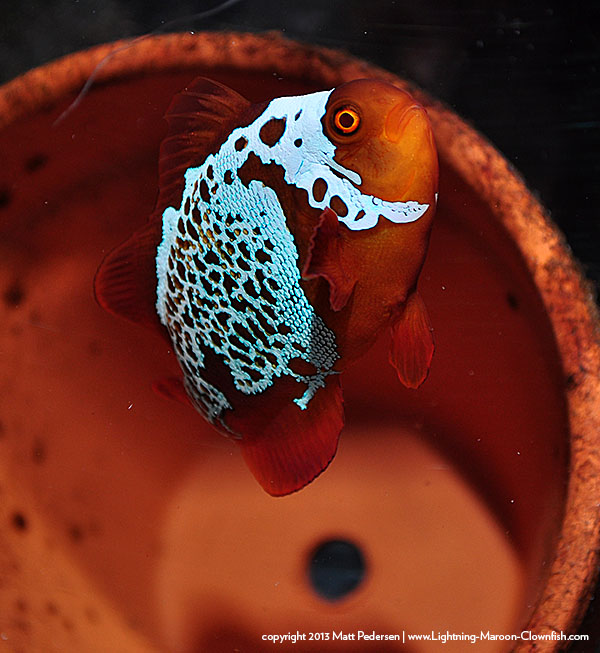
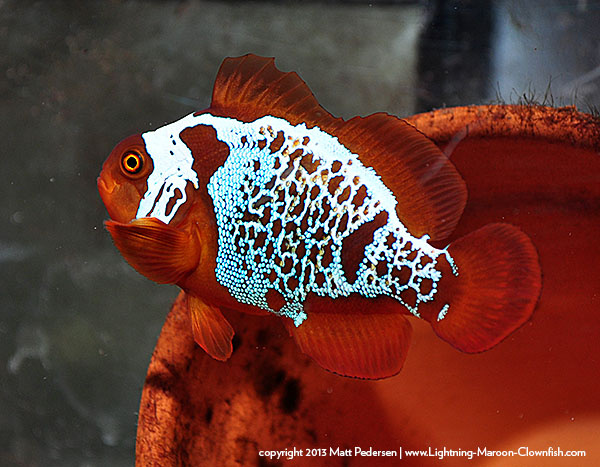
Before I left on my fishing trip last week, I took the liberty to move one of the last summer offspring up into a vacant cube on the cube system, thinking that would free things up for another batch of clowns at some point. I thought it was big enough to NOT go through the holes.
You might remember LM17…
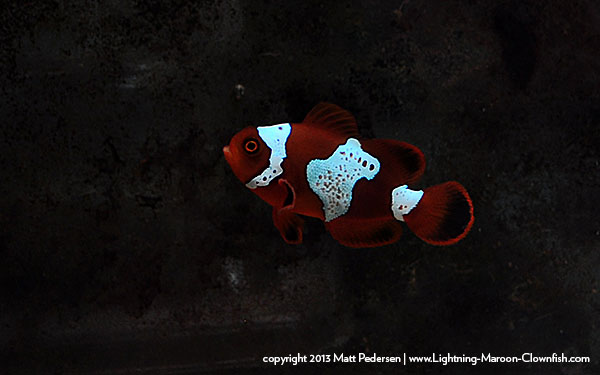
Well LM17 now has a buddy, which I will now dub LM18

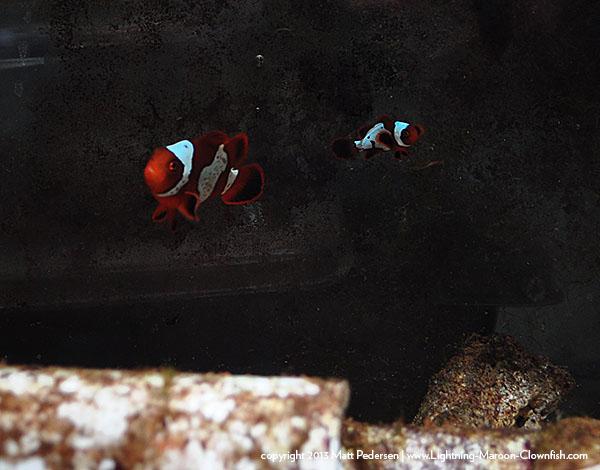
At the moment, LM18 appears to be just about “perfect” as a clownfish. I discovered LM17 and LM18 cohabiting earlier this week, perhaps Monday (it’s now Friday) and opted to take the ‘wait and see’ approach. So far not a nick or scratch. I moved all neighboring fish in the cube system as far away from this “pair” as was possible to help foster whatever pair-bond might form between these two fish. Might be seeing these two offered as a bonded pair sometime in 2014….
For the moment, here’s more of LM18.
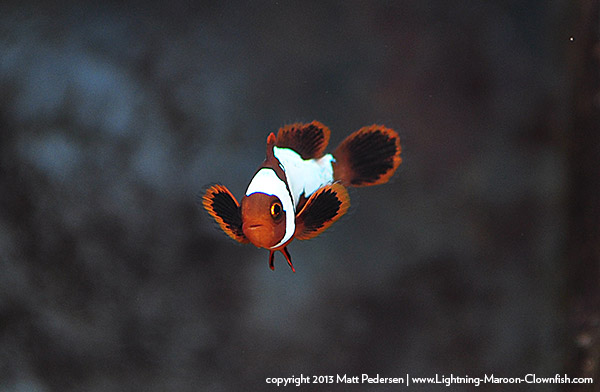
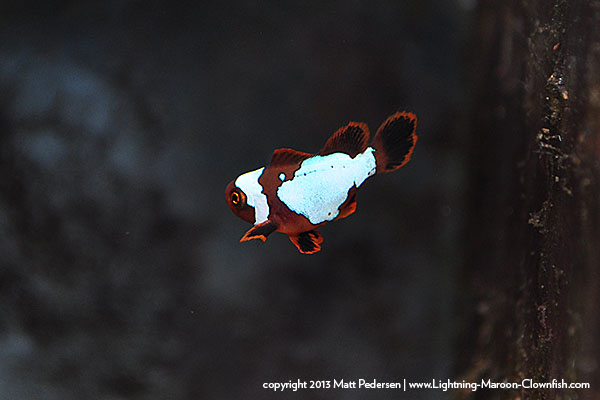

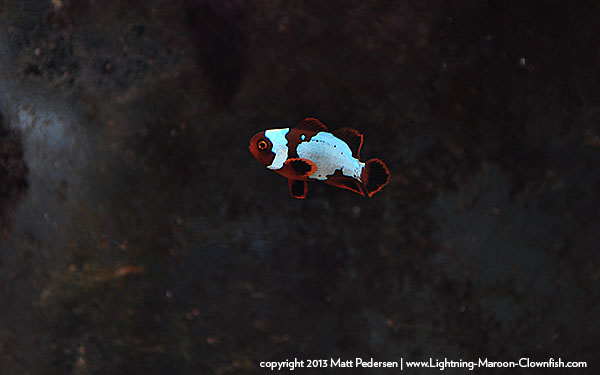
Video of the pair – proof it happened:
I cannot catch a break. Seriously 2013, for all its hard work, has yielded only FOUR (4!!!!) offspring from the Lightning Maroon pair that will grow to be marketable size in 2014!
Spawn #18 was put down on November 28th. This put hatch night as early as Wed, December 4rd, but more likely the 5th, with some possible stragglers on the 6th. The first problem? I was slated to leave town the morning of the 5th and would not return until the morning of the 9th! Thankfully, trusty fellow fish breeder and awesome neighbor Mike Doty was once again on hand to work with the Lightning babies. I was feeling rather confident about that, given that Mike was the guy who reared the big 2012 crop for the first 5 days or so!
I continued to eye the eggs all night on Wed as it transitioned over into Thursday, and at roughly 5 AM Thursday morning none had hatched. I dosed maybe 20-30 ML of Hydrogen Peroxide into the 10 gallon blacked-out larval tank I had used with a prior run, letting it sit for several hours before scrubbing, draining, rinsing, and getting ready for a new clutch. Come 5 AM, I filled the tank with water from the broodstock tank and sanitized the eggs with 4 ML hydrogen peroxide in a half gallon specimen cup for about 15 minutes, before finally setting up the tile with an airstone and calling it a night. I left only 4 hours later.
I heard from Mike that he found some babies, maybe 1/3 of the nest, had indeed hatched out and the rest looked good and would probably hatch Thursday night / Friday morning.
Later, while on a layover in Chicago, came alarming news – Duluth was suffering from a large scale power outage. My normal plan had always been to go rent a generator, but as I was not there to deal with it, after several phone calls and text messages I figured out a battle plan – Frank Wotruba (who has played an integral part in this project and also has a pair of Lightning Maroon offspring) would bring over his generator and set it up to run the central air pump and furnace; he would also take the original wild Lightning Maroon and mate to his house (his power came on fairly quickly).
Thankfully our power came on relatively quickly too…was maybe only out for a couple hours. Relieved, I went on my trip and didn’t give it much thought.
Of course, come Saturday, more bad news. Somewhere along the way, my rotifers had crashed, so Mike was left without any quantity of food to offer. This, combined with the power outage, sealed the fate of Spawn #18; no babies were found by Saturday.
But the bad news continued, as Mike hadn’t noticed that the GCFIs that line the perimeter of the room were all tripped. This is something I was personally aware of; any time the power so much as flickers these things trip. Well…I didn’t think to mention it to Mike during the power outage, so basically while the perimeter tanks had AIR running in them (and those with sponge filters had some active filtration), any tank relying on powered filtration was without. Mike had noticed it come Friday and reset them, but this brought out the next flaw in my system.
Ordinarily, I have a pretty balanced load on my electrical systems, but I’ve come to find that if the tanks get chilled, when bringing the power back on ALL the heaters go on and STAY on. This demand winds up being too much for the circuit, and ultimately it trips the circuit breaker in a few, or several, minutes. Despite removing 500 watts of heaters outright, and downsizing 3 more from 250 to 100 (another 450 watt savings), apparently the reduction of 900 watts was still not enough to prevent this failure. So come Saturday, once again Mike discovered all the tanks not running, and every time he tried to reset the circuit it would trip. More or less, the perimeter tanks, which includes the BROODSTOCK LIGHTNING MAROON’s TANK, had gone without power for over 48 hours. For all the “safety” that these GCFIs are supposed to bring, in the end, I think I will be removing them from my fishroom (or at least trying to find ones that don’t TRIP simply because the power flickers); so far they have only served to cause PROBLEMS rather than to actually do anything beneficial…well…maybe they helped the one time I dropped a light into a tank.
The solution was to actually forego the heaters by shutting down their power strips. Since I revamped the HVAC system of the house this summer to “heat the basement” as an independent zone, I simply instructed Mike to raise the heat from 78F to somethign closer to 82F and leave it be. Upon returning home, I found most things in good shape, although a heavily stocked guppy tank is experiencing loses, and one of my cubes appears to have lost my spawning Centropyge argi pair (I think 7 years old now?) and the other tank inhabitants (although two white stripe lightning maroon offspring that were in breeder nets appear OK?). I’ve skipped feedings on the perimeter tanks, as well as dosed them with Dr. Tim’s ‘One and Only’ which I’ve found to be an exemplary biological filtration kickstarter. I’ll have to water water chemistry now to make sure that I don’t run into problems; hopefully we’re past the worst of it.
2 AM Thanksgiving morning and I’m closing out the fishroom. All but 2 of the babies from Spawn #15 are dead on the bottom of the 10 gallon tank. No warning, only hours earlier everything was fine. I moved the two still alive (one white stripe, one lightning) to an empty tank on the larviculture system. Since there is no pathway in for pathogens, it could only be something related to water chemistry or the introduction of food; the ammonia alert badge remains showing that everything is just fine. No rhyme or reason. Hoping the other two a) make it and b) aren’t going to introduce some pathogen into the larviculture system (I really don’t think they are, but you never know). Could be that something like Vibrio just cropped up and whacked the tank…no clue.
Stumbled across this post last week and figured I’d share it here – Brandon Mehlhoff shared some updates on LM15 and its PNG mate over on Reef2Reef. I snagged one of his videos showing the pair here:
Go see more over about Brandon’s Lightning Maroon on Reef2Reef.com!
In the chaos of preparing for our club’s fundraising table at the TCMAS Frag Swap last night, I was going on 3 hours sleep, up until 3 AM bagging donated corals and such. Somehow along the way I got it in my head that the Lightning Maroons were due to be pulled Saturday night. So when I got back tonight and went to pull the tile, surprise..no eggs. Only now when I sat down to type this did I recheck my counts and realize that last night was the proper night to pull based on how they’ve been hatching recently. Yup, totally botched it, but we raised a LOT of money for the club today with the help and contributions of all our members. So not a total loss, but yeah…boneheaded move.
I should also update on Spawn #16, which is no more and has left me scratching my head. Perhaps 30-50 fish made it through settlement, at which point I turned on the larval system at a slow drip to bring them online. Apparently that was a bad move – the next morning all but two offspring were dead, and those died a short while later. Meanwhile Spawn #15 is going strong.
On a whim I checked eBay tonight, and there it was, the first auction of the next 6 fish to be sold by Blue Zoo Aquatics. They have kicked things off with Lightning Maroon #5 (LM5) – here’s a link to the LM5 Lightning Maroon Clownfish auction on eBay.
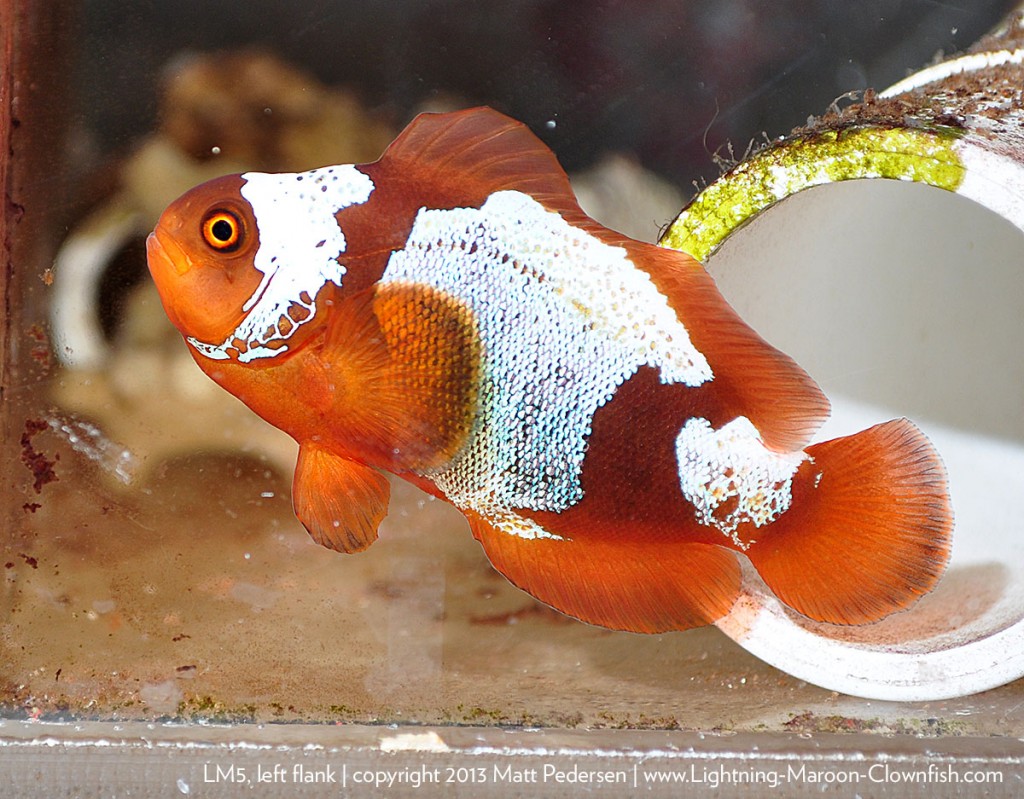
From reading the auction description, it sounds like Blue Zoo will be offering 3 fish now (not sure which three) and three fish after the Thanksgiving holiday, but well before Christmas. This will leave roughly 4 fish here yet to be sold, retained as backups should anything go awry with winter shipping. All of the Lightning Maroon offspring on hand were recently updated with new photos in the inventory.
If all goes well (and it should) then those last 4 will probably be sold in early 2014, with more babies (presumably mainly from spawns #14 and #15) to come by late spring at the earliest. Definitely not getting hundreds or thousands of these fish, which means that until some of my supportive winners get their pairs going, it’s going to be a very limited variant for the near future.
Today (11-16-2013), Spawn #17 was laid. Spawn #14 is clearly showing both forms again (roughly 50/50 split of White Stripe and Lightning Offspring) and Spawn #15 has just completed metamorphosis.
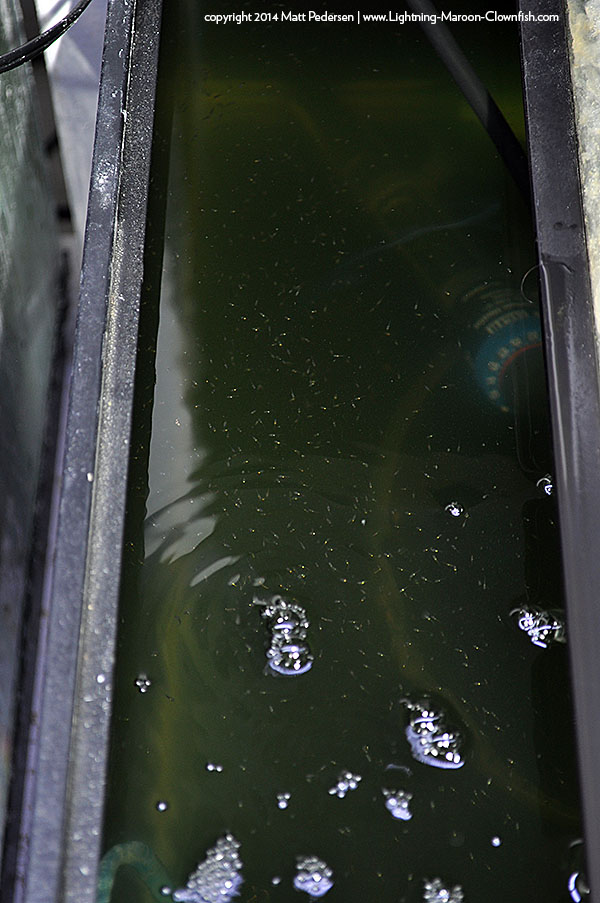
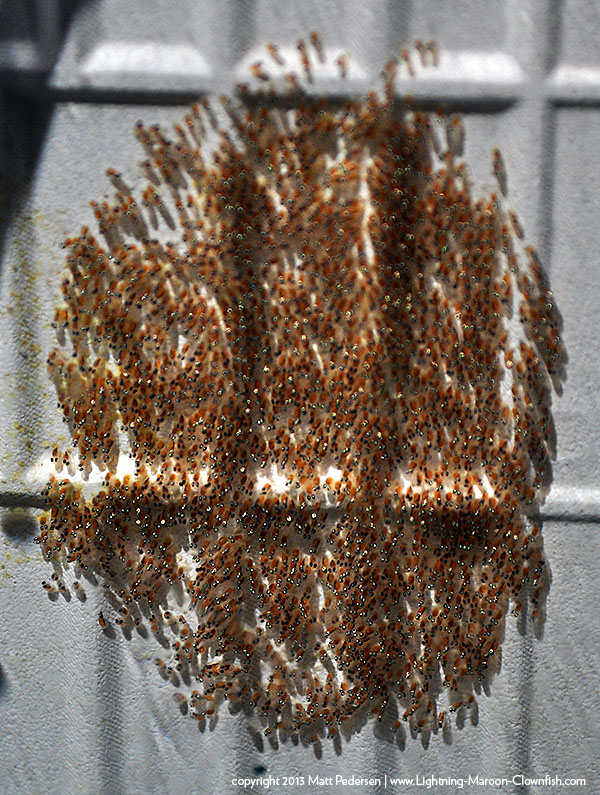
Recent Comments